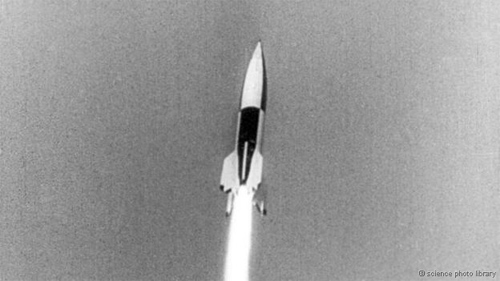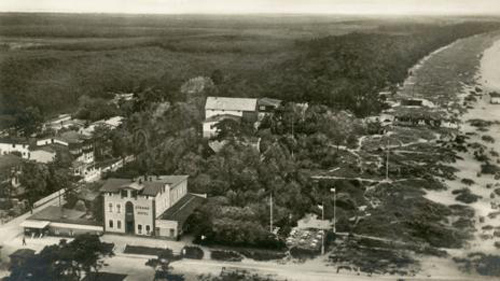The British missed the opportunity to fly into the first universe
In the years following World War II, the British created a daring project to use Nazi missiles to send people into space, but the project failed because of a lack of funding.
The British had intended to fly into space after World War II
After the end of World War II , even in the summer of 1945, Allied forces rushed to study the Nazi V2 rocket secrets. The terrible missiles were built with hard labor, although they did not affect the outcome of the war but contained hidden potential to change the world.

Nazi V2 rocket during World War II.(Photo: BBC)
An unofficial struggle between Americans, Russians, French and British broke out in the process of trying to capture the technology of making V2 rockets, said John Becklake, former chief engineer of restoration V2. at the London Science Museum, revealed.
While the head of Hitler 's vengeful weapons program - Wernher von Braun, surrendered to the Americans in May 1945 and secretly fled to the United States; then the Russians captured Von Braun's research and experimental equipment at Peenemunde on the Baltic coast. The French gathered about 40 German scientists and engineers who studied rockets. But the British collected enough missiles to test a series of cruise missiles.
Records from the British "Interceptor Operation" experiment, firing V2 rockets from the Dutch coast into the air and falling into the North Sea, show that this cruise missile just needs to go further. another three miles (4.8 km) could go out into space - much better results than the German tests during the war.

Peenemunde town in Germany - where the V2 rocket is developed.(Photo: SPL)
Obviously, in terms of technology, Von Braun has solved the fundamental foundations for boosters such as: designing very large size engines, improving fuel pumps fast enough for engine operation and Complex navigation system for missiles. It was really the best high-tech products of the time.
Engineers from the UK Astronomical Society are very interested in the above technologies, to realize the dream of building spacecraft. The member of the association, Mr. Ralph Smith, in 1946 submitted a detailed draft to improve the V2 rocket to "human rocket."
Ralph Smith's Megaroc scheme proposed to increase the size and load capacity of the V2 rocket body cover, expand the fuel storage compartment and replace the warhead with the passenger compartment. The boosters might not be able to carry the passenger compartment out of the atmosphere and instead, the space traveler would be launched in parabolic trajectories 300,000 meters above the ground.
The calculated rocket design will be launched with a small angle, after reaching the orbital peak and then falling back to the ground, the conical nose section will split, the passenger compartment has two windows that will open up slowly. landing. Taking advantage of that travel time, astronauts can observe the ground, the atmosphere and the Sun. In the Western context of confronting the Soviet Union, the Megaroc scheme may be the ideal means to spy on enemy territory.
Megaroc rocket design is evaluated by experts as completely practical, able to bring people into space after several years of implementation.
Ralph Smith submitted the design of Megaroc's rocket to the British Government Department of Supply (MoS) but was refused funding for the study because the financial condition did not allow it, furthermore, the government wanted to focus its resources on Nuclear technology.
Meanwhile, across the ocean, the US military is ready to provide everything for von Braun to develop a V2 rocket to a new generation rocket. As a result, Mercury-Redstone brought the first American astronaut, Alan Shepard, to space in 1961. Redstone has a design quite similar to Ralph Smith's Megaroc, which is essentially an upgrade of V2. No more new technology has been added and has brought people into the universe successfully.
David Baker, technology engineer at the US Aeronautics Agency (NASA) in the Space Shuttle project and a space historian researcher, editor of Spaceflight magazine, said about British technology. Having been ahead of Americans for 10 years, Megaroc is the core core of Mercury-Redstone. In other words, if the Supply Department approves Ralph Smith's project, the world's first astronaut must be English.

The first person to fly into space was recognized by the world as Yuri Gagarin, the Soviet astronaut.(Photo: BBC)
The story of what might have happened does not seem very similar to the era of today's technological development, the era of private boosters, individual owned satellites or space ships. new system. Companies like Virgin Galactic or Xcor are working on making low-cost reusable spaceships, UK's Reaction Engines is developing an advanced propulsion upgrade system for future reusable spacecraft. .
Politicians can cite social values, financial conditions or standards of life to defend, but science and technology will always go ahead, properly prove true value when investing in the future. . " The spirit of Megaroc will forever endure," David Baker said. "We can do it and we can do it again."
- 2010 - Missed events
- Mars explorer ship broke the record in the universe
- The opportunity to find extraterrestrial beings is approaching
- Photos not to be missed
- Opportunity Robot is suffering from dementia
- March 2007: Add a visitor to the universe
- NASA's explorers 'died' after 15 years of exploring Mars
- Autonomous vehicle Opportunity to reach the largest crater in Mars
- The final picture of Opportunity robot was captured and it hurt the online community
- The moment Saturn touches the Moon with ... phone
- Partial lunar images around the world
- Physicists look for dark matter
 The most famous scientific failures in history
The most famous scientific failures in history Mysterious genius mechanic and the machine froze time
Mysterious genius mechanic and the machine froze time The son carries the 'bad gene' of genius Albert Einstein
The son carries the 'bad gene' of genius Albert Einstein Isaac Newton
Isaac Newton